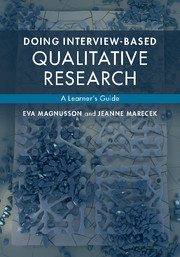Book contents
- Frontmatter
- Contents
- 1 Introduction
- 2 Some examples of interpretative research
- 3 Planning and beginning an interpretative research project
- 4 Making decisions about participants
- 5 Designing the interview guide
- 6 Doing the interview
- 7 Preparing for analysis
- 8 Finding meanings in people's talk
- 9 Analyzing stories in interviews
- 10 Analyzing talk-as-action
- 11 Analyzing for implicit cultural meanings
- 12 Reporting your project
- Epilogue
- References
- Index
10 - Analyzing talk-as-action
Published online by Cambridge University Press: 05 October 2015
- Frontmatter
- Contents
- 1 Introduction
- 2 Some examples of interpretative research
- 3 Planning and beginning an interpretative research project
- 4 Making decisions about participants
- 5 Designing the interview guide
- 6 Doing the interview
- 7 Preparing for analysis
- 8 Finding meanings in people's talk
- 9 Analyzing stories in interviews
- 10 Analyzing talk-as-action
- 11 Analyzing for implicit cultural meanings
- 12 Reporting your project
- Epilogue
- References
- Index
Summary
As you already know, interviews are a form of conversation. That is, research interviews are not only occasions for gathering material pertinent to your researchable questions but also occasions in which two or more persons are interacting. The people interacting in the interview are always doing more with their talk than asking questions and giving answers. For instance, through their talk, people are also continually creating a relationship with their conversation partners; through what they say, they are often also creating relationships with people who are not present. Researchers have used several different terms to refer to these and other interactive functions of talk. Examples are “the action orientation of talk,” “what people do with their talk,” “talk-in-interaction,” “texts and talk in action,” and “talk-as-action.” These different expressions do not have exactly identical meanings; they have their origins in different theoretical traditions. We have settled on one of these terms: talk-as-action (Edwards, 1997). Talk-as-action and its analytical possibilities are the focus of this chapter. We describe how studying talk-as-action can help you address your researchable questions and in some cases develop those questions further.
The analytical framework and procedures that we describe in this chapter bring into focus the interaction work that people's talk does beyond communicating facts, meanings, or opinions to listeners. For instance, if speakers want to persuade listeners of their opinion, they usually use explicit arguments in favor of that opinion. But they also tend to mold the form of their talk in ways that make it more persuasive. These ways may not appear to have anything directly to do with the topic.
The analyses that we describe concern what talk achieves in conversation and how those achievements are conditioned by the context in which the talk occurs. Some of the analyses examine the immediate interpersonal context of the talk, for example, who the conversation partners are. Other analyses focus on the sociocultural context of the talk, that is, the larger societal setting in which the talk is taking place. The chapter begins with an example that illustrates talk-as-action. We then present the analytical framework for the chapter. Next we present a compendium of conversational features that are useful as entry points for analyses of talk-as-action. We illustrate each conversational feature with examples from our own research.
Information
- Type
- Chapter
- Information
- Doing Interview-based Qualitative ResearchA Learner's Guide, pp. 123 - 141Publisher: Cambridge University PressPrint publication year: 2015
